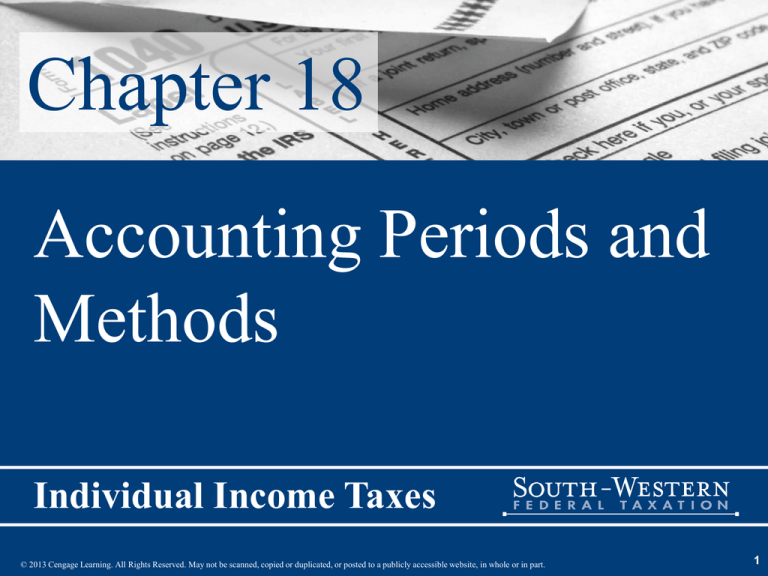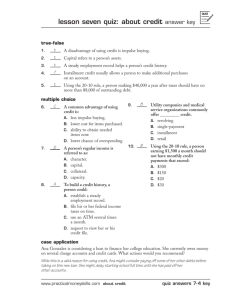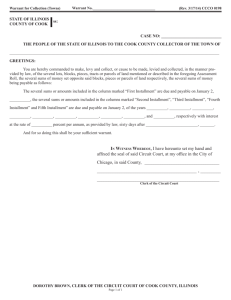
Chapter 18
Accounting Periods and
Methods
Individual Income Taxes
© 2013 Cengage Learning. All Rights Reserved. May not be scanned, copied or duplicated, or posted to a publicly accessible website, in whole or in part.
1
The Big Picture (slide 1 of 3)
• Belinda, Pearl, Inc. (a C corp.), and Tweety, Inc. (an S corp.),
are going to form the Silver Partnership.
• The ownership interests and tax years of the partners are as
follows:
Partner
Partnership Interest
Tax Year Ends
Belinda
25%
December 31
Pearl, Inc.
35%
November 30
Tweety, Inc.
40%
June 30
– The partnership will begin business on April 1, 2012.
2
The Big Picture (slide 2 of 3)
• The partners have several issues they would like for
you to address.
• A potential conflict exists among the partners
regarding when the tax year should end for Silver.
– Belinda and Pearl would like a year-end close to their own
year-ends.
• Tweety would like to have a June 30 year-end.
– Who makes this decision?
• Tweety, since it owns more of the partnership?
• Belinda and Pearl, since collectively they own more of the
partnership?
3
The Big Picture (slide 3 of 3)
• Silver will begin business on April 1, 2012
– Will the first tax year be a ‘‘short’’ tax year or a ‘‘long’’ tax year?
– Will annualization of the net income of the partnership be required?
• When will the partners report their share of Silver’s net
income or net loss on their respective income tax returns?
• Belinda is a cash basis taxpayer, and the other partners use the
accrual method to report their incomes.
– What accounting method must be used to compute Belinda’s share of
the partnership income?
• Read the chapter and formulate your response.
4
Accounting Periods
(slide 1 of 3)
• Taxable year
– The tax year may be shorter but is usually not
longer than 12 months
– Taxpayer elects a tax year by the timely filing of
the initial return
– Permission to change taxable years must be
obtained from the IRS
5
Accounting Periods
(slide 2 of 3)
• Types of taxable years
– Calendar year: January 1 – December 31
– Fiscal year: must start on the first day of a month
and end the last day of a month, other than
December, 12 months later
• Example: July 1 – June 30
6
Accounting Periods
(slide 3 of 3)
• Types of taxable years
– 52/53 week year: ends on same day of week that is
either closest to its normal monthly year-end or
occurs last in its year
• Example: year-end is always the last Saturday in April
7
Accounting Periods— Partnerships
• Tax year-end must be that of (in descending
order)
– Majority interest partners
• Own a > 50% interest in partnership capital & profits
– Principal partners
• Partner with a 5% or more interest in partnership capital
or profits
– Least aggregate deferral of income
8
The Big Picture - Example 3
Least Aggregate Deferral Method (Slide 1 of 3)
• Return to the facts of The Big Picture on p. 18-1.
• The Code and Regulations eliminate the need
for the Silver partners to bargain among
themselves over the tax year-end.
• The partnership’s tax year must end on
November 30
– Using that year-end results in the least aggregate
deferral of partnership income.
– See the following calculation.
9
The Big Picture - Example 3
Least Aggregate Deferral Method (Slide 2 of 3)
• Return to the facts of The Big Picture on p. 18-1.
10
The Big Picture - Example 3
Least Aggregate Deferral Method (Slide 3 of 3)
• Return to the facts of The Big Picture on p. 18-1.
11
Accounting Periods—
S Corps and PSCs
• Generally, these entities must have a calendar
year
– Other tax years may be available if certain
requirements can be met
12
Accounting Periods—Other Allowable
Year-Ends
• Partnerships, S corps, and PSCs can elect to
have other fiscal year-ends if any of the
following are met:
– A valid business purpose can be shown
– §444 election is made and year-end results in no
more than a 3-month deferral
• Requires certain payments
– §444 election was made to retain the same year as
was used for the fiscal year ending in 1987
• Requires certain payments
13
Accounting Periods—Valid Business Purpose
• IRS acknowledges only one valid business
purpose for using a fiscal year-end
– Conforming the tax year to the entity’s natural
business year (seasonal businesses)
• Example: a September 30 year-end may be a natural
business year-end for a swim suit manufacturer
14
Accounting Periods—§444 Deferral and
Required Tax Payments
• Partnerships and S corporations (not their
owners) must make tax payments at the
highest individual rate plus 1% (e.g., 36%) on
estimated deferral period income
– The amount due is reduced by the amount of
required tax payments for the previous year
15
Accounting Periods—§444 Deferral and
Required Salary Payments
• PSCs must pay shareholder-employees salaries
during the deferral period that are at least
proportionate to their salaries for the preceding
fiscal year
– Failure to make required salary payments reduces
PSCs deduction for salaries paid to shareholderemployees
16
Example of §444 Deferral and Required
Salary Payments
• PSC has October 31 year-end and cannot
satisfy the business purpose test for a fiscal
year
– Provides 2 month deferral
– Has one shareholder-employee with $60,000 in
salary for prior fiscal year
– PSC should pay shareholder-employee at least
$10,000 in salary during the deferral period
• $60,000 × 2/12 = $10,000
17
Change in Accounting Period
• Must obtain IRS consent before changing tax
year
• IRS will not consent to a change unless
taxpayer demonstrates a substantial business
purpose for change, such as changing to
natural business year
18
Change in Accounting Period—
Natural Business Year
• Objective test: At least 25% of entity’s gross
receipts are realized in the final 2 months of
the desired tax year for 3 consecutive years
• IRS usually establishes certain conditions that
the taxpayer must accept if approval for
change is to be granted
– In particular, if the taxpayer has a net operating
loss (NOL) for the short period, the IRS requires
that the loss be carried forward
• The loss cannot be carried back to prior years
19
Accounting Periods—
Short Taxable Year
• A short taxable year is a period of less than 12
calendar months
– Can occur in the first taxable year, the last taxable
year, or when there is a change in the taxable year
• If the short-period year is caused by a change
in taxable year, the short-year income must be
annualized
– Necessary due to the progressive tax rate structure
20
Mitigation of the Annual Accounting
Period Concept (slide 1 of 2)
• Several Code provisions provide relief from
harsh results produced by the combined effects
of an arbitrary accounting period & a
progressive rate structure, for example
– NOL carryover rules
• A loss in one year can be carried back 2 years & carried
forward for 20 years
– Special relief is provided for casualty losses
pursuant to a disaster and for reporting insurance
proceeds from destruction of crops
21
Mitigation of the Annual Accounting
Period Concept (slide 2 of 2)
• Farmers and fishermen
– Often subject to wide fluctuations in income
• Allowed to use an averaging system that helps avoid higher
marginal tax rates associated with a large amount of income
received in one year
• Crop insurance proceeds may be received in a year before the
income from the crop would have been realized
– Allowed to defer reporting the income until the year following the
disaster
• Section 451(e) provides similar relief when livestock must be sold
on account of drought or other weather-related conditions
22
Accounting Methods
(slide 1 of 10)
• There are 3 generally permissible overall methods of
accounting
– Cash receipts and disbursements method
– Accrual method
– Hybrid method
• Generally, any of the three methods of accounting
may be used
– Must be consistently employed and clearly reflect income
• In most cases the taxpayer is required to use the
accrual method for sales and costs of goods sold if
inventories are an income-producing factor
23
Accounting Methods
(slide 2 of 10)
• Cash receipts and disbursements method
– Income is recognized when it is actually or
constructively received
– Expenses are deductible when they are paid
• Most courts have applied the “one year rule” for prepaid
expenses
– Requires that prepaid expenses whose benefits extend beyond
the end of the following tax year must be capitalized
24
The Big Picture - Example 14
Cash Equivalent (Slide 1 of 2)
• Return to the facts of The Big Picture on p. 4-1 in Chapter 4.
• Recall that Dr. Cliff Payne has opened a dental
practice as a sole proprietorship and does not
accept credit cards.
• In the 2nd year of business, he adopts a policy
requiring that patients either pay cash when
services are performed or give him a note
receivable with interest at the market rate.
– Generally, the notes can be sold to the local banks
for 95% of their face amount.
25
The Big Picture - Example 14
Cash Equivalent (Slide 2 of 2)
• Return to the facts of The Big Picture on p. 4-1 in Chapter 4.
• At the end of the 2nd year, Dr. Payne has
$60,000 in notes receivable from patients.
• The notes receivable are a cash equivalent and
have a fair market value of $57,000 ($60,000
X 95%).
• Therefore, Dr. Payne must include the $57,000
in his gross income for this year.
26
Accounting Methods
(slide 3 of 10)
• Cash receipts and disbursements method Restrictions on use
– Cash method cannot be used by corporations,
partnerships with a corporate partner, and tax
shelters
• Exceptions:
– Farming business
– Qualified PSC
– An entity that is not a tax shelter whose average annual gross
receipts for most recent three-year period are $5 million or less
27
Accounting Methods
(slide 4 of 10)
• Restrictions on use of cash method (cont’d)
– As an administrative convenience, the IRS permits the
following entities to use the cash method
• Entities with $1 million or less average annual gross receipts during
last three-year period (even if buying and selling inventory) , and
• Certain entities with average annual gross receipts of greater than
$1 million but not more than $10 million during last three-year
period with the following restrictions
– Inventory on hand at the end of the tax year cannot be deducted until
the inventory is sold (i.e., must be capitalized)
– Not eligible are entities whose principal business activity is selling
goods, manufacturing, mining, and certain publishing activities
28
Accounting Methods
(slide 5 of 10)
• Special Rules for Small Farmers
– Although inventories are material to farming
operations, the IRS allows small farmers to use the
cash method of accounting
• Applies to unincorporated farms and closely held
farming corps with gross receipts < $25 million
– Must still capitalize costs of raising trees with
preproduction period > two years
29
Accounting Methods
(slide 6 of 10)
• Special Rules for Small Farmers (cont’d)
– Farmers producing crops that take > 1 year from
planting to harvesting can elect to use the crop
method to report income
• Under the crop method, costs of raising crops are
capitalized and then deducted in year income from crop
is realized
– Cash basis farmers must capitalize the purchase
price of animals, whether acquired for sale or
breeding
• The costs of raising the animal can be expensed
30
Accounting Methods
(slide 7 of 10)
• Accrual method: Income
– Income is recognized when it is earned
• Income is earned when all events have occurred to fix
the taxpayer’s rights to the income, and
• The amount can be determined with reasonable
accuracy
31
Accounting Methods
(slide 8 of 10)
• Accrual method: Deductions
– Expenses are deductible when they meet the all
events test and the economic performance test
– Economic performance test is waived for certain
recurring items
32
Accounting Methods
(slide 9 of 10)
• Hybrid method involves the use of more than
one method
– e.g., A combination of cash and accrual methods
– Generally used when inventory is a material factor
• e.g., Accrual accounting used for determining gross
profit from inventory & cash accounting used to report
other income & expenses
33
Accounting Methods
(slide 10 of 10)
• Change in accounting method
– Taxpayer elects accounting method for subsequent
years by filing the initial return
– Must obtain permission from IRS to change
accounting methods
• Adjustments may be required to prevent distortion of
taxable income
– Correction of error is not a change in accounting
method
34
Disposition Of Net Adjustment From Change in
Accounting Method (slide 1 of 2)
• Required changes in accounting methods are
the result of an IRS examination
– IRS will not require a change unless the net
adjustment is positive
• Adjustment generally must be included in gross income
for the year of the change
• Additional tax and interest on the tax will be due
– If adjustment is > $3,000, the taxpayer can elect to
calculate tax by spreading adjustment over one or
more previous years
35
Disposition Of Net Adjustment From Change in
Accounting Method (slide 2 of 2)
• For voluntarily changes from incorrect
methods and to facilitate changes from one
correct method to another
– IRS generally allows the taxpayer to spread a
positive adjustment into future years
• 1/4th of the adjustment is applied to the year of
change, and 1/4th of the adjustment is applied to each
of the next 3 taxable years
• A negative adjustment can be deducted in the year of
the change
36
Installment Method
(slide 1 of 11)
• Installment method of reporting gain allows
the taxpayer to recognize gain as payments on
the sale are received
37
Installment Method
(slide 2 of 11)
• To qualify for installment treatment, the
taxpayer must receive at least one payment
after the year of sale
• May elect out of installment treatment
38
Installment Method
(slide 3 of 11)
• Installment treatment is not allowed for the following:
– Gains on property held for sale in the ordinary course of business
– Depreciation recapture under §1245 and §1250
– Sale of securities traded on established markets
• As an exception to the first item (above), the installment
method may be used to report gains from sales of the
following
– Time-share units (e.g., the right to use real property for two weeks each
year)
– Residential lots (if the seller is not to make any improvements)
– Any property used or produced in the trade or business of farming
39
Installment Method
(slide 4 of 11)
• Computing the gain recognized:
– Gain recognized each year is dependent on the
payments received during the year
– Recognized Gain =
Total gain
Contract Price
×
Payments Received
40
Installment Method
(slide 5 of 11)
• Definitions
– Total gain = selling price less selling expenses less
adjusted basis of property
– Contract price = Sales price less liabilities assumed
by buyer
• Generally is equal to amount (other than interest) seller
will receive from purchaser
41
Installment Method
(slide 6 of 11)
• If liabilities assumed by buyer exceed the
seller’s basis and selling expenses
– The difference must be added to the contract price
and to payments received in year of sale
42
Installment Method
(slide 7 of 11)
• Depreciation recapture under §1245 & §1250
– Depreciation recapture is ineligible for installment
treatment
• All recapture must be recognized in year of sale
– Because most, if not all, of the gain on the sale of
tangible property is §1245 recapture, benefit of
installment treatment is generally limited to sales
of real property
43
Installment Method
(slide 8 of 11)
• Imputed interest
– Deferred payment contracts where the sales price
exceeds $3,000
• Reasonable rate of interest (at least the applicable
Federal rate) must be charged by taxpayer on the
outstanding balance
• Failure to charge adequate interest will result in imputed
interest at Federal rate
44
Installment Method
(slide 9 of 11)
• Related party installment sales
– Limitations on the use of the installment method
• Nondepreciable property: disposition of property by
related purchaser generally accelerates recognition of
gain on installment obligation for related seller
• Depreciable property: installment method is not
available on sale to controlled entity (i.e., more than
50% interest) unless it can be demonstrated that tax
avoidance was not a principal purpose
45
Installment Method
(slide 10 of 11)
• Disposition of obligation
– Generally, disposition of an installment obligation triggers recognition
of remaining deferred gain
• The gift or cancellation of an installment note is treated as a taxable
disposition by the donor
– The amount realized from the cancellation is the face amount of the note if the
parties (obligor and obligee) are related to each other
• Exceptions are provided for the following transfers
– Tax-free incorporations under § 351
– Contributions of capital to a partnership (transferor partner is taxed on the
income when the partnership collects)
– Certain corporate liquidations
– Transfers due to the taxpayer’s death, and
– Transfers between spouses or incident to divorce
• In such situations, the deferred profit is shifted to the transferee
– Transferee is responsible for payment of tax on subsequent collections
46
The Big Picture - Example 33
Disposition of Installment Obligations
• Return to the facts of The Big Picture on p. 18-1.
• Assume that Belinda’s capital contribution to the
partnership in 2012 was an installment obligation
with a basis of $40,000 and a face amount of
$100,000.
– In 2013, the partnership collected the $100,000.
• The transfer in 2012 was not a taxable disposition,
but in 2013 when the receivable is collected, Belinda
is required to recognize a gain of $60,000.
47
Installment Method
(slide 11 of 11)
• Interest on deferred taxes
– Required to pay interest on the deferred taxes
related to the excess obligation amount (excess of
$5 million) when
• Installment obligation is from sale of property for more
than $150,000, and
• Sum of such obligations outstanding at year-end
exceeds $5 million
48
Long-Term Contracts
(slide 1 of 5)
• Long-term contract defined
– A building, installation, construction, or
manufacturing contract that is not completed
within the same taxable year in which it began
• A manufacturing contract is long-term only if a contract
to manufacture:
– A unique item not normally carried in finished goods
inventory, or
– Items that normally require more than 12 months to complete
49
Long-Term Contracts
(slide 2 of 5)
• Methods of accounting for long-term contracts
– Completed contract: Home construction and
certain other real estate construction contracts if
• The contract is expected to be completed within the
two-year period beginning on the commencement date
of the contract
• The contract is performed by a taxpayer whose average
annual gross receipts for the 3 preceding taxable years
do not exceed $10 million
– Percentage of completion: All other contracts
50
Long-Term Contracts
(slide 3 of 5)
• Completed contract method
– Income recognition occurs when the contract is
completed and accepted
51
Long-Term Contracts
(slide 4 of 5)
• Percentage of completion
– A portion of the gross contract price is included in
income each year as the work progresses
– Amount of revenue accrued:
• (Costs incurred in tax year/total estimated costs) ×
contract price = revenue accrued in tax year
– Current year costs are deductible
52
Long-Term Contracts
(slide 5 of 5)
• Percentage of completion lookback provisions
– In the year that the contract is completed, the profit
and related taxes must be recalculated
• If taxpayer overpaid taxes, interest on the overpayment
is paid to taxpayer
• If taxpayer underpaid taxes, interest on the
underpayment is due from taxpayer
53
Inventories
(slide 1 of 4)
• Generally, tax accounting and financial accounting
for inventories are much the same
– Inventories are necessary to clearly reflect the income of
businesses engaged in the production and/or sale of goods
– Inventories should include all finished goods, goods in
process, and raw materials and supplies
– Inventory rules must give effect to the best accounting
practices, consistently followed from year to year
– All items included in inventory should be valued at either
cost or the lower of cost or market value
54
Inventories
(slide 2 of 4)
• Determining Inventory Cost
– For merchandise purchased, cost is the invoice price less
trade discounts plus freight and other handling charges
• Cash discounts approximating a fair interest rate can be deducted or
capitalized providing the method used is consistently applied
• Uniform Capitalization rules under Section 263A
– Provide that for inventory and property produced by the
taxpayer, the following must be capitalized
• The direct cost of such property, and
• Such property’s share of those indirect costs (including taxes) part
or all of which are allocable to such property
55
Inventories
(slide 3 of 4)
• Lower of Cost or Market
– Except for those taxpayers who use the LIFO
method, inventories may be valued at the lower of
cost or market (replacement cost)
• Taxpayers using LIFO must value inventory at
cost
56
Inventories
(slide 4 of 4)
• A taxpayer may use any of the following methods,
provided the method is consistently applied
–
–
–
–
Specific Identification
First in, first out (FIFO)
Last in, first out (LIFO)
Average cost method
• Farmers who do not use the cash method may elect to
use the farm price method or the unit-livestock-price
method rather than one of the inventory methods
above
57
Refocus On The Big Picture (slide 1 of 4)
• Selection of a tax year - A very precise set of rules
are used to determine the tax year for a partnership,
applied in the following sequence:
– Majority interest tax year - Use the tax year of partners
with a common year-end that collectively own > 50%
interest in capital and profits.
– Principal partners’ tax year - Use this tax year if all
principal partners (5% or greater interest in capital or
profits) have the same tax year.
– Least aggregate deferral tax year - The tax year of the
principal partners (grouped by a common year-end) that
produces the least aggregate deferral of income.
58
Refocus On The Big Picture (slide 2 of 4)
• Alternatively, the partnership can select its tax
year based on a business purpose for the tax
year selected.
– The only business purpose the IRS recognizes is to
conform to the entity’s natural business year.
• Therefore, from the data provided, it appears
that Silver will determine its tax year by using
the least aggregate deferral method.
– Based on this method, Silver’s tax year will end on
November 30 (see the calculations in Example 3).
59
Refocus On The Big Picture (slide 3 of 4)
• Short Tax Year - Silver will have a short tax year
– Begins on April 1, 2012
– Ends on November 30, 2012
• As determined by the least aggregate deferral method.
• Silver will not have to annualize income reported on its first
income tax return.
– Note, however, that annualization will be required if Silver ever
changes its tax year.
• Partner’s Reporting of Share of Net Income - Each partner
will receive a Schedule K–1 that reports the partner’s share of
net income.
– From a timing perspective, the partner will include the Schedule K–1
items on the partner’s income tax return only if a partnership tax year
ends within or with the partner’s tax year.
60
Refocus On The Big Picture (slide 4 of 4)
• Partnership’s Accounting Method - Silver
Partnership must use the accrual method to
compute its income because one of its partners
(Pearl, Inc.) is a C corporation.
– Thus, even though Belinda is a cash basis
taxpayer, her share of the partnership income will
be computed by the accrual method.
61
If you have any comments or suggestions concerning this
PowerPoint Presentation for South-Western Federal
Taxation, please contact:
Dr. Donald R. Trippeer, CPA
trippedr@oneonta.edu
SUNY Oneonta
© 2012 Cengage Learning. All Rights Reserved. May not be scanned, copied or duplicated, or posted to a publicly accessible website, in whole or in part.
62







